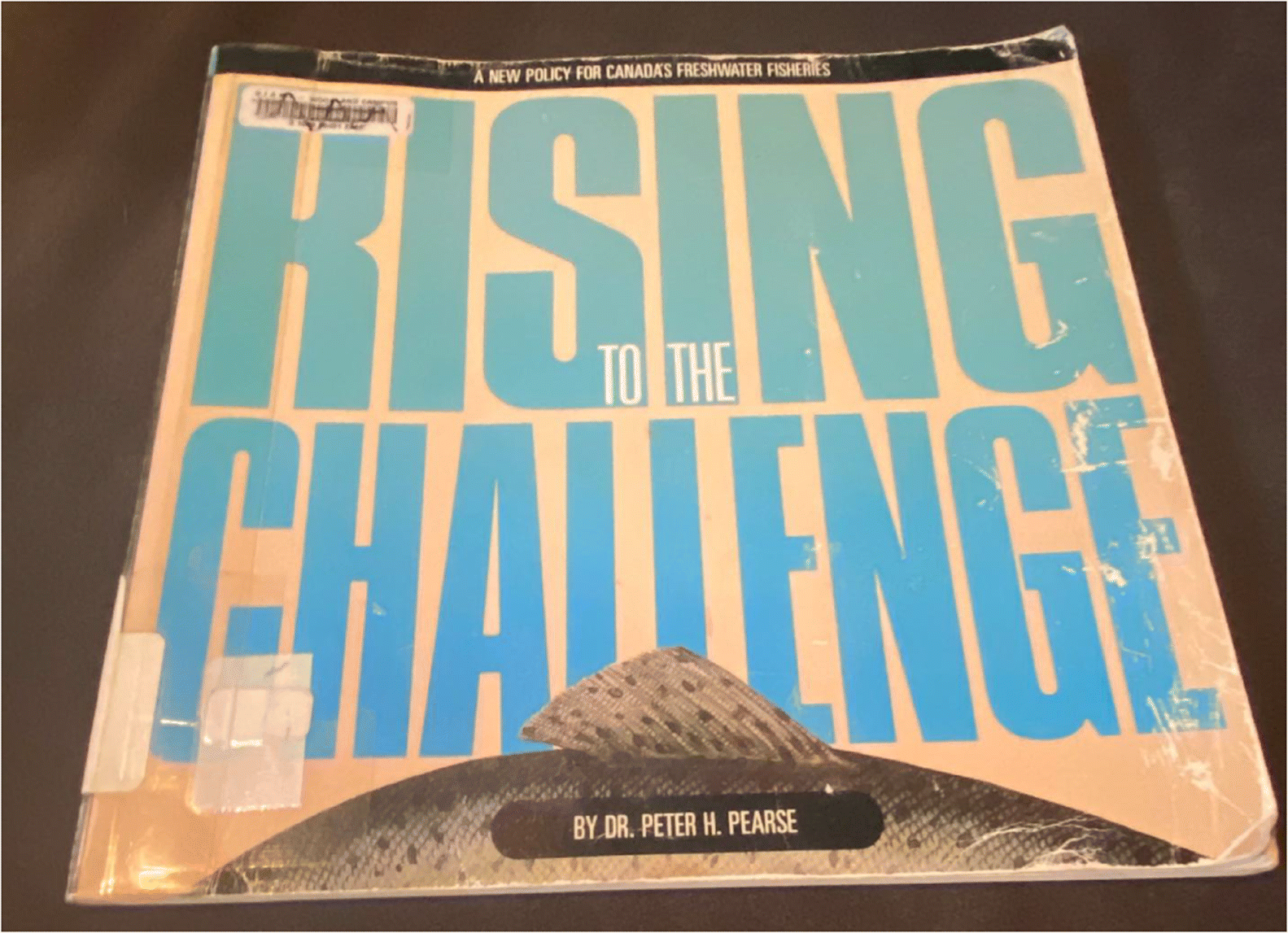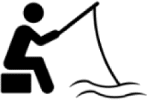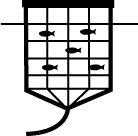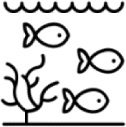Revisiting the challenge: perspectives on Canada’s freshwater fisheries policies three decades after the Pearse Report
Abstract
A seminal report by Peter H. Pearse (1988; Rising to the Challenge: A New Policy for Canada’s Freshwater Fisheries, Canadian Wildlife Federation, Ottawa) outlined 62 policy recommendations focused on the management of Canada’s inland fisheries. Over three decades later, freshwater ecosystems and inland fisheries in Canada are still facing similar challenges with many emerging ones that could not have been foreseen. Here, we reflect on the contemporary relevance of the Pearse Report and propose recommendations that policy makers should consider. Broadly, our recommendations are: (1) manage fishes, fisheries, and habitat using a holistic co-management framework, with clearly defined fishery jurisdictions and partnerships with Indigenous governments; (2) engage in transparent, inclusive, and agile research to support decision-making; (3) facilitate knowledge co-production, involving interdisciplinary projects with diverse groups of actors and sectors including Indigenous Peoples, anglers, policy makers, scientists/researchers, governments, and the public; (4) embrace technological advances to support freshwater fisheries stock assessment and management; and (5) align policy and management activities in Canada with global initiatives related to increasing the sustainability of inland fisheries. We advocate for an updated comprehensive report such as the Pearse Report to ensure that we embrace robust, inclusive, and sustainable management strategies and policies for Canada’s inland fisheries for the next 30 years. It is time to again rise to the challenge.
Introduction
Canada’s two million lakes (Downing et al. 2006) and expansive network of rivers support freshwater fish populations and the fisheries sectors that depend on them (Casteneda et al. 2020). Ensuring the sustainability of inland fisheries resources comes with challenges because fisheries are managed at various scales ranging from local to provincial/territorial to national. Fisheries are also used by multiple sectors (i.e., Indigenous, commercial, recreational) simultaneously who use a diverse suite of capture techniques and practices (e.g., dipnets, seines, gillnets, rod and reel) across highly varied landscapes (e.g., ponds, montane rivers, the Laurentian Great Lakes; Cooke and Murchie 2015). The Indigenous, commercial, and recreational fisheries sectors provide a myriad of cultural value, socio-economic benefits, and sources of food to Canada (Brownscombe et al. 2014; Castenada et al. 2020). Despite the many governments (including Indigenous governments), stakeholders and rightsholders involved in managing Canada’s inland freshwater fisheries, these resources remain jeopardized by local and broadscale threats that are challenging to mitigate. Further, the North American model of wildlife management hinges on information (e.g., stock assessments or research) to support decision-making processes or policies (Organ et al. 2012; Cooke and Murchie 2015; although the model is imperfect—see Artelle et al. 2018). Despite research output in science and technology generally increasing in Canada, it has decreased in the fisheries realm (Canadian Council of Academics 2012), jeopardizing effective management. User conflicts, low social priority, insufficient funding and research, and widespread habitat degradation are persistent problems in freshwater fisheries of the developed world (Arlinghaus et al. 2002), and freshwater fisheries face challenges related to their lack of visibility more broadly (Cooke et al. 2016a). Geographic and biological variability are additional challenges that constrain fundamental activities such as stock assessment (Lorenzen et al. 2016). Canada is not exempt from this and faces added challenges due to the geographic vastness of its freshwater fisheries (Cooke and Murchie 2015). Yet, many of Canada’s freshwater fisheries are managed sustainably and while Canada is exemplary in many aspects of inland fisheries, persistent challenges (e.g., geographic vastness, lack of priority) create a tall task for even the most capable management systems (Stephenson et al. 2019). Because of its size, most inland fisheries in Canada are assessed and managed at a regional or provincial/territorial level and there tends to be a lack of coordinated data collection, information management systems, and analysis across jurisdictions (Post et al. 2016; Casteneda et al. 2020).
Fisheries management is complex, multifaceted, and typically focused on three domains: habitat, fishes, and the actors involved (Nielsen 1993). Thus, diverse policy and management tools are required for successful management (Lapointe et al. 2014). The vastness of Canada and its fresh waters result in impracticalities for detailed biological assessments on all waterbodies (Lorenzen et al. 2016), leaving fisheries to be typically managed at the landscape scale (Lester et al. 2003), despite facing differential localized environmental and harvest pressures. Further, freshwater ecosystems are particularly vulnerable because when fresh water is extracted, diverted, contaminated, or contained for human use, its value as habitat for organisms becomes compromised (Geist 2011). Additionally, inland systems are vulnerable to overexploitation (Allan et al. 2005). For example, Post et al. (2002) detailed the invisible collapse of a number of high-profile recreational fisheries across Canada as the result of overharvest that went unnoticed due to challenges with monitoring diffuse resources.
Further complicating management success are conflicts among resource-use sectors and various management authorities (Lynch et al. 2017). Issues are further amplified by complex and interacting external stressors, such as climate change, habitat alteration (arising from e.g., urbanization, hydropower development, agriculture, resource extraction), and pollution (Minns 2015; Reid et al. 2019; World Wildlife Fund 2020). Freshwater fisheries are affected by almost all land-use changes (Hynes 1975), such that discussions about fisheries cannot easily be decoupled from integrated water resource and watershed management (Nguyen et al. 2016). At a North American scale, the “grand challenges” for the management of inland fisheries have been articulated (see Lynch et al. 2017) and emphasize the work that is still needed to achieve sustainable inland fisheries (Cooke and Murchie, 2015). With many pressures facing Canada’s inland ecosystems (Minns 2015; Gutowsky et al. 2019; Pérez-Jvostov et al. 2020; Desforges et al. 2021), there is a need for evidence-based management strategies and policies to keep pace with constantly evolving anthropogenic stressors and changing socio-economic contexts to enable sustainable fisheries for today and tomorrow (Lapointe et al. 2014; Arlinghaus et al. 2015).
Over three decades ago, the Canadian Wildlife Federation (CWF; a nongovernmental organization dedicated to wildlife conservation) recognized the complexities associated with managing freshwater fisheries in Canada. They first commissioned Dr. Bill Beamish (a professor at the University of Guelph) to scientifically assess the status of freshwater resources and identify stressors and threats facing recreational fisheries (Phase I; Beamish et al. 1986). Beamish et al. (1986) determined that in more populated regions intense and widespread human impacts were associated with increased settlement and exploitation, causing species-specific population declines. Threats identified by Beamish regarding Canada’s freshwater fisheries included habitat degradation, overexploitation, and an overreliance on stocking (Phase I; Beamish et al. 1986). Next, CWF commissioned Dr. Peter Pearse (at the time a professor at the University of British Columbia) to prepare a report on the management of freshwater fisheries (Phase II; Pearse 1988; Fig. 1). Pearse’s objectives were to assess the situation, identify solutions, and draw the attention of the fishing community, management agencies, and the public to the need for action. The resulting Pearse Report has been used by the Senate Standing Committee on Fisheries in discussions of the future of freshwater fisheries in the North (The Standing Senate Committee on Fisheries 2002), referenced by the Auditor General of Canada while reviewing water resources in Canada (Auditor General of Canada 2010; Canadian Council of Academics 2012), and has been referred to during hearings of the Parliamentary Fisheries Committee while deliberating on the state of recreational fisheries in Canada in 2015 (see openparliament.ca/committees/fisheries/41-2/45/dr-darryl-smith-1/only/). Furthermore, the Pearse Report was foundational in developing and refining freshwater fisheries management practices in a variety of jurisdictions in Canada including Alberta (A Fish Conservation Strategy for Alberta 1998).
Fig. 1.

The seminal Pearse Report concluded with a plea to change Canadian freshwater policies to better serve “our children and grandchildren as well as ourselves” yet, unfortunately, many of the challenges that managers faced then still exist today. As a working group of early career researchers in fisheries science in Canada (i.e., the first generation of children that Pearse was hoping to make changes for) with a diverse set of expertise working in nongovernmental organizations, federal and provincial agencies, aquaculture, and academia, we are well positioned to reflect on the 62 recommendations made by Pearse in 1987. We were joined by several more established fisheries professionals active in inland fisheries management, policy, and science in Canada. Our objective here is to review Pearse’s recommendations, reflect on their relevance today, and provide new or refined recommendations with Pearse’s aim of improving the status of Canada’s fresh waters for the next generation.
There have been many changes and developments in freshwater fisheries management across Canada since the initial publishing of the Pearse Report; therefore, it is our aim to advocate for a second, modernized volume of the Pearse Report. Our efforts are simply to make it clear that it is time to do so and to share some ideas on what is possible and should presumably be central to a more comprehensive update. This paper is not intended to be that update (Pearse had an entire book—we have 8000 words). Indeed, we recognize that the ideas presented here represent our collective lived experiences and knowledge (i.e., our viewpoint and perspective), rather than the outcome of extensive focused consultation and engagement with relevant actors across Canada. Such efforts to listen and learn should be encouraged, but are beyond the scope of this paper. We acknowledge that all members of the team are settlers, such that the perspectives provided here fail to embrace the diverse perspectives held by Indigenous communities and knowledge holders and Indigenous fisheries professionals in Canada. We fully acknowledge that, although the North American model of fish and wildlife management is the prevailing framework for management of natural resources in Canada (30 years ago and today), it is flawed in that it fails to adequately or respectfully include Indigenous knowledge and perspectives (see Hessami et al. 2021).
Approach
For the 62 original recommendations (Table 1), we discuss below where they have been implemented successfully or poorly and whether they are still relevant today. We updated Pearse’s original recommendations (Table 2) and discussed today’s relevancy for each of seven sections (i.e., Recreational Fisheries, Indigenous Fisheries, Commercial Fisheries and Aquaculture, Towards More Effective Management, Strengthening Organization and Administration, Supporting Knowledge Production (Indigenous, Science, and Experiential), and Public Participation). We acknowledge that, although the Pearse Report was composed of different themes, many of these are inherently overlapping and intertwined. As such, we have concentrated our efforts on these distinct sections, also recognizing that these recommendations were made 30 years ago and terminology, such as “fisherman” and “native”, has since changed. We use the original terms when directly referring to Pearse’s recommendations; however, we will use the updated terms such as angler or fisher (depending on context) and Indigenous, respectively. We also approach this task recognizing that there have been a number of fundamental changes since 1988 that were not apparent to Pearse at the time of his report (e.g., the Supreme Court of Canada Sparrow Decision, the formation of the new territory known as Nunavut, or the Internet).
Table 1.
| Section | Theme | Recommendation |
|---|---|---|
The Fish Test | National strategy for freshwater fisheries | 1. The freshwater fisheries must be accorded higher priority by Canada’s federal, provincial, and territorial governments, in keeping with the problems these fisheries face and their importance to Canadians. |
Governing the Fisheries | Making the system work | 2. Government should publish clear statements of their freshwater fisheries policies, setting out their responsibilities, objectives, and strategies for achieving them. |
Recreational Fisheries | Meeting the management challenge Commercial side of recreational fisheries | 3. Fisheries agencies should balance their traditional emphasis on managing stocks and increasing the supply of fish with stronger measures to manage the demands of fishermen. 4. Recreational fishing policy should be directed toward improving the quality and variety of fishing opportunities. 5. Governments should experiment with licensing arrangements that enable local user and community groups to manage designated recreational fisheries under approved management plans. 6. Sportfishing regulations should be designed with more attention to the different local conditions and needs of different fisheries. 7. Governments should require all recreational fisherman to hold licenses, whether a fee is charged or not, and co-operate to provide consistent nationwide information. 8. Licensing systems should put more emphasis on supporting the special needs of different fisheries, less on distinguishing among fishermen on the basis of their age and other characteristics. 9. Fees for sportfishing fishing licenses should be raised to reflect the cost of improved fisheries management. 10. As fees for sportfishing privileges are raised, the higher rates for Canadian non-residents of a province or territory should be eliminated. 11. Governments should make fishing license procedures easier to understand and licenses easier to obtain. 12. Governments should adopt guidelines and, if necessary, regulations for fishing competitions to protect stocks and the fishing environment. 13. Sportfishing organizations should adopt policies to promote good sportsmanship and environmental values, rather than commercial values, in the conduct of sportfishing competitions. Provincial and territorial conservation organizations should monitor major events and the development of competitive fishing in their regions. 14. Government tourist agencies should review the potential for expansion of tourism based on fishing, in conjunction with fisheries managers, and in consultation with fisheries user groups. Plans to promote tourism should be coordinated with fisheries management plans. 15. Governments should design licensing arrangements to enable commercial sportfishing enterprises to assume responsibilities for managing selected fisheries under approved management plans. |
Indigenous Fisheries | Quest for harmony Essentials for successful negotiation Legislative and administrative repairs Keeping the lines open | 16. Fishing organizations and governments should seek clarification of native fishing rights and support negotiated agreements to accommodate them pending resolution of claims and treaty rights. 17. Native fishing agreements should assure each native group a specific allocation of fish. The quantity and kind of fish allocated should be determined through negotiations, primarily in reference to recent catches, but also recognizing special circumstances relating to population trends and economic opportunities. 18. Governments should clearly define the water to which native band fishing bylaws apply, by legislative amendment if necessary, and these specifications should be cited in negotiated fishing agreements. 19. The federal government should affirm by legislative amendment the precedence of the Fisheries Act over the Indian Act in the management of the fisheries. 20. Negotiations of interim fishing agreements with native groups should include the question of how fish may be used. Where quotas are established and adequate controls on catches are included, governments and other interest groups should be receptive to proposals for orderly marketing of the catch. 21. The Department of Fisheries and Oceans should see to the creation of a native fisheries advisory committee in each region of locality where there is no other continuing consultative body. |
Commercial Fisheries & Aquaculture  | Overcapacity Governments’ role in marketing Control of incidental catches Aquaculture | 22. Federal and provincial governments should extend individual quota licensing systems to promote efficient development of their commercial freshwater fisheries. 23. Government should review subsidies and price support mechanisms in the freshwater commercial fisheries to ensure that they continue to serve a valid developmental function, rather than contribute to overcapacity. 24. The governments participating in the Freshwater Fish Marketing Corporation should sponsor a thorough, independent review of the structure, organization, ownership, powers and performance of the corporation. 25. Governments, in co-operation with the Seafood Advisory Council, should support well-planned programs aimed at developing new markets for freshwater fish. 26. Governments should take measures to reduce incidental catches of non-target fish in commercial fishing operations. 27. Governments should facilitate but not subsidize the development of commercial aquaculture. 28. Governments should sponsor carefully directed research and training programs in aquaculture. |
Toward Effective Management | Management objectives Managing fishing Fish habitat management Stock management Integrating stock and habitat management Co-ordinating management efforts | 29. Fisheries plans reflecting the diversity of fisherman’s demands should be prepared for each region. Plans should set objectives for the type of fishing, abundance, and yields for each important species or stock in each fishery to be managed and for the type and extent of habitat required. 30. Wherever recreational, native, and commercial fisherman compete for the same fish, governments should allocate specific shares of the available catch to each group after ensuring that enough fish escape for conservation purposes. 31. Governments should examine introducing transferable catch quotas to make it possible for competing groups to negotiate mutually advantageous reallocations. 32. Methods of managing the catch of individual recreational fishermen should be selected to meet the particular objectives of each fishery. 33. Techniques for regulating the numbers of fisherman permitted access to particular fisheries should be explored in order to provide special fishing opportunities. 34. The Department of Fisheries and Oceans should press ahead with putting the new habitat management policy into effect by: a) preparing habitat management plans for areas under federal jurisdiction, clearly setting out fish production targets against which potential losses from development can be measured, b) negotiating agreements with other levels of government to define common resource management goals and guidelines for habitat replacement, restoration, and development, c) establishing habitat steering committees where required for major development projects. 35. The Fisheries Act should be amended to accommodate integrated resource management. 36. Regulations should be adopted under the Fisheries Act to authorize activities that affect fish habitat. The approval arrangements should be coordinated with licensing and permitting processes in each province and territory. 37. The responsibilities of developers for conservation of fish habitat should be attached to development permits and licenses. 38. The Government of Canada and the governments of the provinces should vigorously promote international co-operation in controlling hazardous wastes, acid rain, and other pollutants of air and water. 39. Stocking of hatchery fish should be used cautiously, according to the plans and objectives for the particular fisheries, with careful attention to possible biological and ecological effects. 40. The Salmonid Enhancement Program should be reoriented to put more emphasis on rehabilitating natural stocks though habitat improvement, rather than through expanding hatcheries; meeting specific management objectives for particular fisheries; evaluating the effectiveness and efficiency of the program from both a scientific and socioeconomic standpoint. 41. Regional fisheries plans should include appropriate habitat management and enhancement measures as well as stock improvement measures to be undertaken to meet fishing targets. Allocation and other fisheries measures should be reviewed to ensure they are consistent with these integrated plans. |
Strengthening Organization and Administration | Assigning responsibilities Devolution of the territories Administration and financing Regulation, licensing, and enforcement | 42. In their forthcoming discussion about constitutional responsibilities for fishers, First Ministers should consider transferring primary responsibility for freshwater fisheries to provincial jurisdiction. 43. The Federal government should negotiate comprehensive freshwater fisheries agreements with each of the provinces and territories, remedying the many shortcomings in existing arrangements. The agreements should clearly define the role and responsibility of each government with respect to management, science, and other matters relating to freshwater fisheries. Administrative responsibility for fisheries management- fishing, fish-habitat and fish-stock- should be assigned to the provinces and territories to the extent constitutionally possible. 44. Responsibility for the non-anadromous fisheries in Yukon and Northwest Territories should transferred from federal government to the territorial government, together with funding and human resources adequate to the increasing value and importance of these fisheries. 45. Governmental agencies responsible for freshwater fisheries should periodically review their administrative structure and operations to ensure that they are efficiently organized to meet their responsibilities. 46. Administrative responsibility for all fish habitat protection provisions in the Fisheries Act should be assigned to the Department of Fisheries and Oceans. 47. The financial resources needed for improvements in fisheries management should be raised primarily through revenues from fishing privileges. 48. Governments should strengthen the effectiveness of enforcement as a deterrent by increasing penalties for violation of fisheries laws and regulations, by making a greater effort to educate the judiciary in the social and economic seriousness of violations of resource conservation rules, and by improving their own enforcement programs through better education and direction of field officers. |
Scientific Support | Scientific roles and responsibilities The social sciences Science priorities | 49. Governments with management responsibilities should strengthen their in-house capacity to conduct continuing research and information gathering required to provide scientific support for freshwater fisheries management. 50. Governments should support the development of centers of excellence in fisheries science and training in selected universities and colleges. 51. Government science programs should incorporate a new effort to study and explain fisheries values, the social and economic aspects of managing fisheries, and the effects of licensing and other institutional arrangements. 52. An independent freshwater fisheries advisory committee should be appointed to advise fisheries deputy ministers on science—including social science—priorities, appropriate divisions of scientific responsibility among governments and their agencies, and data requirements for management. Committee reports should normally be made public. |
Public Participation | Getting involved The freshwater fisheries constituency The participation record Information, education, and communication | 53. Associations and groups concerned with the environment, wildlife, and conservation should give greater attention to the freshwater fisheries and strengthen their efforts to represent their interests in these fisheries to the public and to governments. 54. To assist in developing innovative fisheries policies, provincial, territorial, and national wildlife organizations should organize strong fisheries policy development committees to consult with relevant government agencies, and those agencies should make provisions for effectively channeling their advice into the policy-making process. 55. Local sportfishing organizations should examine opportunities for assuming management responsibilities for specific fisheries under direction of license from fisheries management agencies. 56. The Canadian Wildlife Federation should, as a follow-up to the inquiry on freshwater fisheries policy, invite interested groups to join together in establishing a national Freshwater Fisheries policy, invite interested groups to join together in establishing a national Freshwater Fisheries Association to represent the interests of the freshwater fisheries to the Canadian public and to governments. 57. The National Recreational Fisheries Conference should be reviewed with a view to expanding its sponsorship to include the proposed national Freshwater Fisheries Association, increasing the frequency of conferences to one a year, and adding regional conferences where appropriate to improve information exchange about new policies and programs at the regional level. 58. A survey and evaluation of arrangements for freshwater fisheries advisory groups throughout the country should be one of the first tasks of the proposed Freshwater Fisheries Association 59. The proposed Freshwater Fisheries Association should seek the support of governments and the private sector to establish an independent national recreational fisheries institute with the objective of promoting public participation in recreational fisheries maintenance, rehabilitation, and enhancement projects throughout Canada. 60. All jurisdictions should publish their fisheries regulations as part of a broader, attractive publication explaining the rules and informing anglers how they can derive more enjoyment from fishing by participating in the preservation and enhancement of the fisheries. 61. The proposed Freshwater Fisheries Association should develop a communications plan to improve public and media information about the freshwater fisheries. This program should include a regular high-quality magazine or newsletter and the use of other vehicles such as films, videocassettes, and information kits. 62. The proposed Freshwater Fisheries Association should co-operate with other interested organizations and government agencies in preparing high-quality educational material on fisheries for use in schools. |
Table 2.
| Section | New Recommendation |
|---|---|
Recreational Fisheries | 1. Align efforts by managers, researchers, and anglers in pursuit of the common goal of ensuring that the benefits of recreational fisheries outweigh their costs. 2. Expand capacity for human dimensions research related to recreational fisheries in fisheries management agencies in Canada that lack such capacity. 3. Engage in experiments with different input and output controls where the sustainability of open-access recreational use is uncertain or unlikely. |
Indigenous Fisheries | 4. Enhance support for local co-management agreements (and institutions) that acknowledge Indigenous People’s right to fisheries management involvement. 5. Ensure that cooperative management actions are considered proactively and preemptively in areas where Indigenous fisheries overlap with other sectors. 6. Equip fisheries professionals with knowledge on Indigenous culture, rights and sovereignty, and the skills to engage and interact with Indigenous communities and knowledge holders in a respectful and meaningful way. 7. Consider the findings of both Phase 1 and 2 Indigenous Program Review Reports provided by the National Indigenous Fisheries Institute when policymakers are involved with interim agreements. 8. Encourage inland fisheries professionals to consider “Two-Eyed Seeing” as a guiding framework, which encourages unified perspectives from both Indigenous and western knowledge systems, for the benefit of all. |
Commercial Fisheries | 9. Mitigate by-catch and the spread of aquatic invasive species via bait harvest and sale. 10. Ensure that freshwater fishes harvested in Canadian waters continue to reach the global market, while also supporting domestic markets and providing Canadians with a local and healthy food source. 11. Implement fisheries ecolabelling and sustainable certification programs in freshwater systems. |
Aquaculture | 12. Encourage the development of closed-containment aquaculture facilities that reduce environmental risk to freshwater ecosystems. |
Effective Management | 13. Establish quantitative targets to facilitate assessment of the effectiveness of new or modified policies. 14. Ensure that fisheries management agencies and organizations adopt evidence-based approaches to fisheries management that rely on robust evidence synthesis, structured decision making and other forms of decision science. 15. Explore the idea of more formalized delegation agreements between federal and provincial/territorial governments where appropriate. |
Strengthening Organization and Administration | 16. Develop evidence-based regulations and policies that prioritize the protection of riparian and shoreline habitats, and limit land-use change at watershed scales. 17. Consider using soft management and self-compliance programs to manage recreational and small-scale commercial fisheries. |
Supporting Knowledge Production | 18. Adopt knowledge co-production models when undertaking inland fisheries research to bridge the science-action gap. 19. Focus research on emerging issues (or those that are just being acknowledged) such as threats associated with aquatic invasive species, climate change, the role of Indigenous governance and management, socioeconomic values of fisheries, knowledge transfer/co-production, translating science into policy, recreational values, and the role of community science/environmental champions. 20. Adopt an adaptive and agile approach to allocating research funds and facilitating the production of rigorous, scientific fisheries research. 21. Increase the stability of funding and production of scientific expertise throughout government turnover. 22. Adopt a more inclusive approach to science that includes Indigenous and experiential knowledge and engages marginalized fisheries actors, including women and racialized communities. |
Public Participation | 23. Find new ways to get the public involved in freshwater issues to make fish more ‘visible’ to Canadians. 24. Use technologies and the internet to foster communication and promote involvement among groups that could otherwise not collaborate in person due to travel costs and impracticalities. 25. Leverage technological advancements to make regulations more accessible, attractive, and concise for anglers. 26. Conduct studies to understand the best information channels and strategies for educating anglers and sharing responsible fishing practices. |
Overarching Recommendations | 27. Manage fish, fisheries, and habitat holistically, with clearly defined jurisdictions and co-management among provincial/territorial, federal and Indigenous rightsholders and relevant stakeholders. 28. Engage in transparent, inclusive and agile research that focuses on existing and emerging issues. 29. Increase effort and funding for knowledge co-production involving interdisciplinary projects with diverse groups of actors including Indigenous peoples, anglers, policy makers, scientists/researchers, governments, and the public. 30. Use modern technological advances to support freshwater fisheries stock assessment and management while enabling greater engagement with stakeholders and rightsholders in ways that are respectful and meaningful. 31. Align policy and management activities in Canada with global initiatives including the UN Ten Steps to Responsible Inland Fisheries. |
Recreational fisheries
Summary
On the topic of recreational fisheries, Pearse (1988) offered recommendations that are summarized here: managers should shift to managing angler demands instead of straining to meet certain problematic expectations; managers should acknowledge recreational fisher heterogeneity and incorporate it as a central consideration; recreational fishers should play more prominent roles in funding management (i.e., through licensing) and supporting conservation; fishing regulations and licensing should be tailored to meet local and (or) fishery-specific needs and be both manageable and understandable from the perspective of anglers; competitive sportfishing should be managed to prevent overexploitation and instill conservation ethics; and commerce related to recreational fisheries should be monitored and considered more closely by managers (e.g., as a management tool).
Troublesome angler expectations, debates about the cost and regulation of fishing, and issues related to management capacity still abound in recreational fisheries. Funding and regulation are limited by numerous factors, such as political instability and the (un)willingness of participants to pay for and (or) support management actions. Regulations must be complex to meet fishery-specific needs and yet, simple enough for users to understand (Cooke et al. 2016b). Recreational fishery managers face a significant geographic and logistical challenge in trying to manage a multitude of widespread fisheries, with relatively small agencies and limited resources. Management is also complicated by the exceptional social and ecological complexity of recreational fisheries: recreational anglers are a very heterogeneous user group (Beardmore et al. 2015), whose impacts on freshwater fisheries are often complex and difficult to discern (e.g., due to cryptic fisheries mortality and complex angler behaviour; Post et al. 2002).
Updated recommendations
Compared to some other recreational activities (e.g., downhill skiing), the costs of angling in Canada remain relatively low. This is both a strength and a weakness of recreational fisheries. Appreciation for recreational fishery value and significance has grown in the last 30 years, as researchers have recognized the significant socioeconomic and other values associated with recreational fishing (Arlinghaus and Cooke 2009; Cooke et al. 2016b). Managers, researchers, and anglers should align their efforts in pursuit of a common goal: ensuring that the documented benefits of recreational fisheries (e.g., angler stewardship, increased well-being; Tufts et al. 2015) outweigh their costs. Researchers should continue their efforts to accurately account for and balance these costs and benefits and to provide information on the human dimensions of recreational fisheries to ensure sustainable use and maximize socioeconomic benefits. This could not have been quantified if not for long-term national surveys of recreational anglers in Canada conducted at 5-year intervals (see Brownscombe et al. 2014); this important survey should continue. Although most natural resource management agencies have biological science capacity, similar capacity related to the human dimensions (e.g., social science, economics; Bennett et al. 2017) is often lacking. Human dimensions are particularly salient to recreational fisheries (Hunt et al. 2013), but have applications across all sectors and issues. Resource-management agencies in provinces such as Ontario and British Columbia now employ research scientists who may focus on various “human” questions (e.g., angler preferences, recreational boating spatial patterns; Hunt et al. 2019). Such work provides timely and valuable insight on recreational exploitation, angler preferences and heterogeneity, emergent problems, and the potential for users to conserve and support management of freshwater fisheries. The aforementioned recreational fishing survey is one example of progress in this area, but the ways in which recreational anglers are incorporated in fisheries management remain unscientific in many instances (e.g., hand-picking stakeholders for consultation, nonprobabilistic collection of fishery user data). Internal capacity for human dimensions research should be increased in recognition of these facts.
Liberal exploitation by recreational anglers was enabled in the past by many historically abundant inland fisheries, but this is increasingly untenable and has led to the collapse of some inland fisheries (Post et al. 2002). Managers should consider experimenting with different input and output controls (see limited-entry licensing; Jeanson et al. 2021) where the sustainability of open-access recreational use is uncertain or unlikely (see Cox et al. 2002). Where possible, managers may increase capacity by decentralizing selective parts of recreational fishery management and enabling recreational anglers to assume more responsibility for freshwater fishery health (e.g., participation in fisheries advisory councils, assuming stewardship roles; Elmer et al. 2017). Recreational anglers should play a strong supporting role in fisheries management and may do so passively (e.g., by purchasing a license and complying fully with regulations) or actively (e.g., engaging in stewardship, adopting informal regulations; Cooke et al. 2013a). Each group must contribute actively to the change(s) that they wish to see in recreational fisheries (Elmer et al. 2017).
Indigenous fisheries
Summary
Pearse recognized that Indigenous fishing rights are complex and poorly defined—a “crazy quilt” as he described it. This section of the Pearse Report attempted to focus on individual subsistence fisheries, although small-scale Indigenous commercial fisheries (so-called moderate livelihood fisheries) are somewhat intertwined. Pearse went into considerable depth outlining the history of Indigenous fishing rights incorporated in the Constitution, the Indian Act, the Fisheries Act, provincial law, comprehensive land agreements, and the many treaties that Canada has signed with Indigenous Peoples. His recommendations sought the clarification of fishing rights in legislature, development of interim agreements, and the promotion of resource co-management.
The challenges surrounding Indigenous fisheries 30 years ago remain today, as the tangled legislation pertaining to Indigenous fishing rights has changed very little. For example, Pearse described difficulties of relying on the courts to settle disputes, where vague legal definitions and excruciatingly slow processes can often lead to unpredictable outcomes. Although the Supreme Court has upheld Indigenous fishing rights in numerous landmark cases since Pearse’s Report was published (see Sutherland 2000; reviewed in Casteneda et al. 2020), Indigenous Peoples should not have to undergo legal scrutiny every time their fishing methods come into question. We recognize that the decentralized legal framework for individual fishing rights has made it challenging to produce Canada-wide changes; however, little progress has been made to clarify vague definitions in the legislation for those seeking a “moderate livelihood”. Fortunately, recent amendments to the Fisheries Act in 2019 include a provision to address violations outside of the courts using alternative measures agreements (Fisheries and Oceans Canada 2021).
Updated recommendations
We recommend continued support of local (and meaningful!) co-management agreements (and institutions) that acknowledge Indigenous People’s right to fisheries management (Popp et al. 2019). We strongly recommend that cooperative management actions are considered proactively and preemptively in areas where Indigenous fisheries overlap with other sectors. Additionally, fisheries professionals should be better updated on these rights and sovereignty and should also be equipped with skills to engage in a respectful and meaningful way (see Wong et al. 2020), consistent with the UN Declaration for the Rights of Indigenous Peoples (UNDRIP; un.org/development/desa/indigenouspeoples/declaration-on-the-rights-of-indigenous-peoples.html). The National Indigenous Fisheries Institute conducted a two-phase external review of Fisheries and Oceans Canada’s (DFO) Indigenous programs, 2017–2019, and there are many similarities to Pearse’s final recommendations concerning co-management, relationship building, and recognition of rights. We strongly suggest that policy-makers involved with interim agreements consider the findings of both Phase 1 and 2 Indigenous Program Review Reports provided by the National Indigenous Fisheries Institute (indigenousfisheries.ca/en/indigenous-program-review/) and also adhere to the guidance in UNDRIP (see Gomez Isa 2019). We would also suggest that those involved in inland fisheries research and management consider “Two-Eyed Seeing” as a guiding framework for their research (Reid et al. 2020), which encourages unified perspectives from both Indigenous and western knowledge systems, for the benefit of all (Barlett et al. 2012). Such approaches are increasingly being used in the context of freshwater fisheries in Canada (Alexander et al. 2021), yet Indigenous knowledge is still not fully embraced by fisheries practitioners (Kadykalo et al. 2021), which is alarming.
Commercial fisheries and aquaculture
Summary
Canada’s freshwater commercial fishing industry was and continues to be composed of relatively few fishers (compared to the recreational sector where there are millions of participants) that account for most commercial harvest (Casteneda et al. 2020). This industry provides job opportunities in regions that have limited economic activity. It is closely regulated by provincial/territorial and federal agencies, and all individuals participating in commercial activities must have a license and adhere to strict catch quotas. Fishers that are part of the Freshwater Fish Market Corporation (FFMC) have exclusive rights to process and market fish. Pearse was aware of the monopolization of the FFMC and mentions that this corporation is under continuous debate. The FFMC sets a price for each species caught prior to the beginning of the season and pays fisherman 80% of the total value. The overall objective of Canadian commercial fisheries policy is to create maximum contribution to the economy, social welfare, and income for those employed. Attention is needed to ensure the industry maintains productivity, quality, and maximum value for the catch. By-catch is of concern, but does not occur to the same damaging extent in all freshwater systems (reviewed in Raby et al. 2011) and Pearse broadly reviewed methods that might reduce by-catch.
The production of fish by means of aquaculture was recognized by Pearse as an important and growing industry in Canada’s fresh waters (Fisheries and Oceans Canada 2019), supporting Indigenous, commercial, and recreational fisheries. Aquaculture can allow for fisheries operations to be better controlled, safer, and closer to markets. The Canadian government provides funding to aid in the development of environmentally safe aquaculture facilities (i.e., the Fisheries and Aquaculture Clean Technology Program). However, these benefits do come with inherent risks, including holding-impoundment accidents allowing the release of domestic fish into the wild stocks (see Patterson and Blanchfield 2013 for example from Lake Huron) and the release of harmful waste into the ecosystem (Ellis 1996; Naylor et al. 2005), both of which are significantly reduced by shifting to closed-containment aquaculture. Suggestions made by Pearse were to create additional fishing rights to improve the sector’s economic performance and that support was needed for the development of commercial and the aquaculture industries in remote areas.
Updated recommendations
The issues surrounding by-catch warrant further investigation and mitigation (Raby et al. 2011) as does the spread of aquatic invasive species via bait harvest and sale (Drake and Mandrak 2014; Hunt et al. 2020). Science-based policies to mitigate by-catch issues and to ensure a responsible and sustainable bait fish industry are sorely needed in jurisdictions where such activities are not prohibited. Quebec has banned the use of live baitfish in inland waters, apparently without a discernible negative effect on recreational fishing experiences. Marketing of fish harvested in Canadian waters should continue to target the global market, but also ensure fisheries are not subject to overcapacity. There are also opportunities to better capitalize on freshwater fish as a local source of safe food for consumers in Canada. Moreover, there is a need and opportunity to implement fisheries ecolabelling and sustainable certification programs in fresh water (see Cooke et al. 2011) given their relative success in the marine realm (e.g., Ponte 2012).
Canadian freshwater aquaculture facilities should focus their attention on innovations that promote the production of this closed-containment aquaculture facilities, rather than operations in open waterbodies. Moving operations towards this closed-containment method of aquaculture will provide fish for market while reducing the environmental risks present with the current open-water aquaculture operations (Ellis 1996; Naylor et al. 2005).
Towards more effective management
Summary
The recommendations in this section intended to weave together those made in the previous recreational, Indigenous, and commercial sections of the Pearse Report. People, place, and fishes were and continue to be intertwined, and Pearse advocated that their management should be too. The amount of fishing permitted affects stock size, which is dependent on the productivity of their habitat. As stressed in earlier sections, not just fish, but also good fishing experiences need to be considered. The complexities of a multilayered management system are as alive today as they were in the 1980s and are discussed in more detail in the next section. As such, we very much echo Pearse’s recommendations here.
Updated recommendations
We concur with Pearse regarding the need to better integrate the management of people, place, and fishes, and we would add that policies should include quantitative targets to facilitate assessment of the efficiency of new policies. Although legislation protecting fish habitat has recently been updated to prevent future habitat loss (Hasler et al. 2021), there are insufficient policies and funding (e.g., federal Habitat Stewardship Program) to adequately address the current degraded state of fish habitat in many areas. There is an urgent need to identify effective habitat restoration strategies to ensure wise use of limited financial resources. In general, there is also a need for management agencies to adopt evidence-based approaches to fisheries management that rely on robust evidence synthesis (Cooke et al. 2017), structured decision-making (Irwin et al. 2011), and other forms of decision science (see Bower et al. 2018) rather than relying on institutional traditions and norms (see Young et al. 2016). This approach has been adopted by DFO via their Canadian Science Advisory Secretariat process, but most of those activities are marine in focus. Similar decision-making processes are needed at other levels of government given the potential for open science and transparency in decision-making to enhance management (Roche et al. 2022).
Strengthening organization and administration
Summary
The recommendations from this section of the Pearse Report sought the reorganization of freshwater fisheries administration, mainly through the amendment of the constitution to give primary jurisdiction of freshwater fisheries to provincial/territorial legislation. In addition, Pearse highlighted the effectiveness of self-compliance programs when addressing the public. Presently, the federal government primarily manages freshwater habitat (i.e., through the Fish and Fish Habitat Protection Program; dfo-mpo.gc.ca/pnw-ppe/ffhpp-ppph-eng.html), whereas provincial and territorial governments are largely responsible for harvest and land-use management. However, the potential revisitation of government policy through election cycles remains a constraint when trying to improve fisheries administration in the long term (Hasler et al. 2021). Furthermore, many waterways connect interprovincially or internationally with the United States, and in these cases, primary provincial control becomes difficult, and federal governance is often favoured, including via nonbinding treaties for international waters. Ultimately, the recommendations that Pearse proposed in terms of the organization and administration of freshwater fisheries continue to be relevant in the present day and have yet to be achieved nationwide.
Updated recommendations
It continues to be evident that provincial and territorial governments (as well as co-management agreements with Indigenous governments) are more appropriate administrators of freshwater fisheries than the federal government. Therefore, we recommend that the federal government explore the idea of more formalized delegation agreements with provincial/territorial governments where appropriate. Governments should also provide evidence-based regulations and policies to prioritize the protection of riparian and shoreline habitats (e.g., guidance on details such as widths of buffers), which are equally important in maintaining freshwater ecosystems. Watershed-based land-use planning should also limit land-use alteration beyond thresholds demonstrated to affect freshwater ecosystems. In addition, governments should continue to advocate soft management and self-compliance programs to manage recreational fisheries, although there still is a need for oversight and accountability. With the Canada Water Agency currently in development (see thenarwhal.ca/opinion-canada-water-agency-protect-freshwater/), it will be important to consider if and how water quality and quantity are considered in the context of fisheries resources, while also trying to understand how yet another agency fits into the multi-scalar governance patchwork.
Supporting knowledge production (Indigenous, science, and experiential)
Summary
The scientific-support recommendations from the Pearse Report focused on the need to increase research capacity within governments, to better explain values of fisheries and management via increased in-house effort, university/college training, and an independent fisheries advisory commission. Since the Pearse Report, government agencies have continued to generate applied research (to varying extents based on internal capacity and resources) to support freshwater fisheries management, with growing reliance on external partners (e.g., in academia, industry, Indigenous organizations, and the NGO sector). There have been increasing numbers of partnerships and co-advising of graduate students between governments and universities, mainly supported by Tri-Agency funding, Genome Canada, and Canada Foundation for Innovation, with additional funding from government agencies, industry, and NGOs. There are also a growing number of examples of well-funded pan-Canadian research networks and initiatives focused on generating actionable knowledge to support freshwater fisheries management (e.g., GenFish gen-fish.ca/; FishCAST fishcast.ca/; Canadian Aquatic Invasive Species Network nserc-crsng.gc.ca/Business-Entreprise/How-Comment/Networks-Reseaux/CAISN-CAISN_eng.asp). Pearse stated that government science should examine social and economic fisheries values, and this recommendation remains highly relevant. The last scientific-support recommendation, that an independent fisheries advisory committee should be appointed, has not been achieved; however, other commissions have aimed at filling this gap on smaller spatial scales (such as Great Lakes Fishery Commission or Pacific Salmon Commission). To this day, producing knowledge to examine fisheries remains multifaceted for many reasons, including the complex nature of the working landscape (Bissix and Rees 2001) across multiple government levels, with many different actors involved. Knowledge production, both at the time of the Pearse Report and in the present day, can mean different things to different people and organizations, ultimately leading to discrepancies during policy making and implementation of management decisions (Sullivan et al. 2006).
Updated recommendations
Pearse’s scientific-support recommendations still stand, and we emphasize the importance of interdisciplinary research contributing to the growing body of literature that examines knowledge co-production (Djenontin and Meadow 2018). Effective knowledge co-production (research that is conducted in a collaborative, respectful, and engaged manner to create actionable science) could contribute to Pearse’s scientific-support recommendations. Further, knowledge co-production could also facilitate implementation of recommendations from other sections as well, by collaboratively producing research to bridge the science-action gap (Cooke et al. 2020). Next, we recommend that the government and other research actors (such as funding agencies, academia, or NGOs) focus on issues and topics that have emerged (or are being acknowledged) since the Pearse Report publication, such as threats associated with aquatic invasive species (Mandrak and Cudmore 2010; Drake and Mandrak 2014; Hunt et al. 2020), climate change (Ficke et al. 2007; Poesch et al. 2016), the role of Indigenous governance and management (Popp et al. 2019), socioeconomic values of fisheries, knowledge transfer/co-production, translating science into policy, recreational values (Skubel et al. 2019), and the role of community science/environmental champions (Taylor et al. 2012). Additionally, modernization and paradigm shifts in science and research since the Pearse Report have resulted in new and emerging scientific disciplines with greater appreciation of the role of human dimensions (Bennett et al. 2017). We recommend taking an adaptive and agile approach regarding emerging issues in the future, with the goal of government and other research actors facilitating the frontiers of fisheries research by continuing to fund and facilitate the production of rigorous, scientific fisheries research. To produce agile and adaptive research, there is a need for greater reliance on foresight science, which is a systematic approach that draws upon different analytical and predictive tools to provide insight about escalating and newly emerging trends (Cook et al. 2014). For example, horizon scanning is designed to explore futures by systematically examining information sources to detect early indications of development and change (Hines et al., 2019) to predict and prepare for future challenges (Pérez-Jvostov et al. 2020). Next, the importance of funding stability and production of scientific expertise should be emphasized in efforts to provide continuing support for research despite government turnovers (Death of Evidence 2012). Specifically, the core funding scheme for fisheries science within Canada (i.e., Natural Sciences and Engineering Research Council of Canada and Social Sciences and Humanities Research Council) should have funding safeguarded to ensure foundational research remains supported under all government climates. Finally, we recommend taking a more inclusive approach to science that includes Indigenous and experiential knowledge and engages marginalized fisheries actors including women and racialized communities (Chaudhury and Colla 2021).
Public participation
Summary
Pearse included 10 recommendations regarding public participation, which he organized into the four themes: getting involved; the freshwater fisheries constituency; the participation record; and information, education, and communication. Pearse pressed for increased visibility for freshwater recreational fisheries from all levels of government and outlined how participation programs could be “strengthened, especially through education, and communication”. In contrast to the 1980s, today’s availability of the internet, digital communication, and learning has fundamentally transformed the public participation framework. Overall, these recommendations require some updating and modification to be relevant in today’s world.
Updated recommendations
To modernize Pearse’s recommendations, we suggest additional recommendations regarding public participation. First, we propose continued efforts to find new ways (e.g., educational programs/technology) to get the public interested and involved in freshwater issues to make fishes more “visible” to Canadians to promote actions leading to the conservation of freshwater fishes (see Cooke et al. 2013b). Second, we propose using technologies (e.g., phone apps; Venturelli et al. 2016) and the internet to foster communication and promote involvement among groups that could otherwise not collaborate in person due to travel costs and impracticalities. Third, we suggest that governments continue to leverage technological advancements to make regulations more accessible, attractive, and concise for anglers. For example, governments could use QR codes at access sites to share only relevant regulations to anglers, simplifying the process of finding information. We also recommend the continued study and use of media platforms consumed by anglers to share fishing best practices and regulations given the growing recognition of the importance of using informal channels to enable responsible and sustainable fisheries (Cooke et al. 2019). It would also be useful to establish a culture where anglers are also advocates and stewards for freshwater biodiversity more broadly given that exploitable species depend on healthy and productive aquatic ecosystems (Cowx et al. 2010). A recent analysis of the state of freshwater biodiversity in Canada (i.e., Desforges et al. 2021) revealed that freshwater biodiversity is in remarkably poor condition in Canada, emphasizing the need for engaging inland fisheries actors in the protection and restoration of inland ecosystems.
Recommendations and conclusion
The Pearse Report represents a seminal piece of fisheries management and policy advice, which remains important and topical to this day. There is continued urgency to resolve some of the issues that were outlined in the Pearse Report; however, there have also been many challenges that have emerged since the late 1980s. We have built upon Pearse’s initiative by providing additional recommendations for policy makers’ consideration toward effective fisheries management. Relevant to all sections of the Pearse Report, we recommend that fishes, fisheries, and habitat should be managed holistically, with clearly defined jurisdictions and co-management among provincial/territorial, federal and Indigenous rightsholders and relevant stakeholders. Doing so will require additional funding given the gravity and scope of the task. Efforts to ensure that politicians and diverse publics value inland waters and the fisheries they support are sorely needed (Cooke et al. 2013b). Additionally, we emphasize the importance of transparent and agile research that focuses on disciplines that have emerged since the original publication and onwards into the future. Specific research needs include the human dimension of fisheries (including issues related to shared governance and better understanding the role of human behaviour), developing strategies to mitigate the introduction of aquatic invasive species, and developing management actions that incorporate climate-change adaptation. Further, we suggest that there be increased effort and funding for knowledge co-production, involving interdisciplinary projects with diverse groups of actors including Indigenous Peoples, anglers, policy makers, scientists/researchers, governments, and the public. We recommend using modern technological advances to support freshwater fisheries research (e.g., telemetry, eDNA, angler apps, drones, transcriptomics) and management while enabling greater engagement with stakeholders and rightsholders in ways that are respectful and meaningful.
In addition to these specific recommendations, we also encourage efforts to better align with the UN Ten Steps to Sustainable Inland Fisheries (see fao.org/3/a-i5735e.pdf). The Ten Steps are a template for achieving a world where people can responsibly use freshwater ecosystems and their fishery resources today and in the future (Cooke et al. 2016c). There are opportunities to downscale these Ten Steps and apply them at national and regional scales, but something that has yet to be fully realized (Lynch et al. 2020). When combined with the Ten Steps framework and the Pearse Report, our recommendations represent a starting point; however, we stress the need for more in-depth efforts to review and improve fisheries policy and management in Canada.
Here, we recognized the importance of the Pearse Report and it was our aim to bring it to the attention of a new generation of fisheries professionals. Just as Pearse concluded his first report with a plea to change Canadian freshwater policies to better serve “our children and grandchildren as well as ourselves”, we offer our own plea; the development of a second, modernized volume of the Pearse Report. Further, coordination of updates to both the scientific assessment of the inland fisheries (i.e., the Beamish Report) and examination of management and policies (i.e., the Pearse Report) would support the development of robust, inclusive and sustainable management strategies and policies for Canada’s inland fisheries for the next 30 years. These efforts should be inclusive with significant opportunity for diverse knowledge holders and resource stewards to offer their perspectives. This should also be done at arms-length from government (but with government funding and information sharing) to ensure objectivity. With much work left to be done to preserve Canada’s vast, yet increasingly threatened, freshwater fisheries for our children and grandchildren, it is our hope that the considerations and recommendations presented here will contribute to sustainable and robust management strategies and policies. We recognize this is but a first step and strongly encourage the governments that hold ultimate authority for our inland fisheries resources to respond to our plea. It is time again to rise to the challenge.
Acknowledgements
We thank Andrea Reid for providing a friendly review.
References
Alberta Government. 1998. A fish conservation strategy for Alberta. [online]: Available from open.alberta.ca/dataset/7d24e762-07f9-41d9-a457-5c13ba359d66/resource/9ef9d98c-120a-4dee-89b1-03d5a4012e82/download/aenv-fish-conservation-strategy-for-alberta-2000-2005-74958.pdf.
Alexander SM, Provencher JF, Henri DA, Nanayakkara L, Taylor JJ, Berberi A, et al. 2021. Bridging Indigenous and Western sciences in freshwater research, monitoring, and management in Canada. Ecological Solutions and Evidence, 2(3): e12085.
Allan JD, Abell R, Hogan ZEB, Revenga C, Taylor BW, Welcomme RL, et al. 2005. Overfishing of inland waters. BioScience, 55(12): 1041–1051.
Arlinghaus R, and Cooke, SJ. 2009. Recreational fisheries: Socioeconomic importance, conservation issues and management challenges. In Recreational hunting, conservation and rural livelihoods: Science and practice. Edited by B Dickson, J Hutton and WM Adams. Blackwell Publishing Ltd. pp. 39–58.
Arlinghaus RK, Lorenzen K, Johnson BM, Cooke SJ, and Cowx IG. 2015. Managing freshwater fisheries: Addressing habitat, people and fish. In Freshwater Fisheries Ecology. Edited by JF Craig. Blackwell Publishing Ltd. pp. 557–579.
Arlinghaus R, Mehner T, and Cowx IG. 2002. Reconciling traditional inland fisheries management and sustainability in industrialized countries, with emphasis on Europe. Fish and Fisheries, 3(4): 261–316.
Artelle KA, Reynolds JD, Treves A, Walsh JC, Paquet PC, and Darimont CT. 2018. Hallmarks of science missing from North American wildlife management. Science Advances, 4: eaao0167.
Auditor General of Canada. 2010. 2010 Fall report on the commissioner of the environment and sustainable development [online]: Available from oag-bvg.gc.ca/internet/English/parl_cesd_201012_02_e_34425.html.
Bartlett C, Marshall M, and Marshall A. 2012. Two-eyed seeing and other lessons learned within a co-learning journey of bringing together Indigenous and mainstream knowledges and ways of knowing. Journal of Environmental Studies and Sciences, 2(4): 331–340.
Beamish FW, Healey HPJ, and Griggs D. 1986. Freshwater Fisheries in Canada. Report on Phase I of a National Examination. Canadian Wildlife Federation, Ottawa, Canada. 155 pp.
Beardmore B, Hunt LM, Haider W, Dorow M, and Arlinghaus R. 2015. Effectively managing angler satisfaction in recreational fisheries requires understanding the fish species and the anglers. Canadian Journal of Fisheries and Aquatic Sciences, 72(4): 500–513.
Bennett NJ, Roth R, Klain SC, Chan KM, Clark DA, Cullman G, et al. 2017. Mainstreaming the social sciences in conservation. Conservation Biology, 31(1): 56–66.
Bissix G, and Rees JA. 2001. Can strategic ecosystem management succeed in multiagency environments? Ecological Applications, 11(2): 570–583.
Bower SD, Brownscombe JW, Birnie-Gauvin K, Ford MI, Moraga AD, Pusiak, RJ, et al. 2018. Making tough choices: Picking the appropriate conservation decision-making tool. Conservation Letters, 11(2): e12418.
Brownscombe JW, Bower SD, Bowden W, Nowel L, Midwood JD, Johnson N, et al. 2014. Canadian recreational fisheries: 35 years of social, biological, and economic dynamics from a national survey. Fisheries, 39(6): 251–260.
Canadian Council of Academics. 2012. The State of Science and Technology in Canada [online]: Available from cca-reports.ca/reports/the-state-of-science-and-technology-in-canada-2012/.
Casteneda RA, Burliuk CMM, Casselman JM, Cooke SJ, Dunmall KM, Forbes LS, et al. 2020. A brief history of fisheries in Canada. Fisheries, 45(6): 303–318.
Chaudhury A, and Colla S. 2021. Next steps in dismantling discrimination: Lessons from ecology and conservation science. Conservation Letters, 14(2): e12774.
Cook, CN, Wintle BC, Aldrich SC, and Wintle BA. 2014a Using Strategic Foresight to Assess Conservation Opportunity. Conservation Biology, 28:1474–1483.
Cooke SJ, and Murchie KJ. 2015. Status of aboriginal, commercial and recreational inland fisheries in North America: Past, present and future. Fisheries Management and Ecology, 22(1): 1–13.
Cooke SJ, Murchie, KJ, and Danylchuk AJ. 2011. Sustainable “seafood” ecolabeling and awareness initiatives in the context of inland fisheries: Increasing food security and protecting ecosystems. BioScience, 61(11): 911–918.
Cooke SJ, Suski CD, Arlinghaus R, and Danylchuk AJ. 2013a. Voluntary institutions and behaviours as alternatives to formal regulations in recreational fisheries management. Fish and Fisheries, 14(4): 439–457.
Cooke SJ, Lapointe NWR, Martins EG, Thiem JD, Raby GD, Taylor MK, et al. 2013b. Failure to engage the public in issues related to inland fishes and fisheries: Strategies for building public and political will to promote meaningful conservation. Journal of Fish Biology, 83(4): 997–1018.
Cooke SJ, Allison EH, Beard TD, Arlinghaus R, Arthington AH, Bartley DM, et al. 2016a. On the sustainability of inland fisheries: Finding a future for the forgotten. Ambio, 45(7): 753–764.
Cooke SJ, Arlinghaus R, Johnson BM, and Cowx IG. 2016b. Recreational fisheries in inland waters. In Freshwater Fisheries Ecology. Edited by JF Craig. Blackwell Publishing Ltd. pp 449–465.
Cooke SJ, Bartley DM, Beard TD, Cowx IG, Goddard C, Fuentevilla C, et al. 2016c. From Ideas to Action: Ten Steps to Responsible Inland Fisheries that Support Livelihoods, Food Security, and Healthy Aquatic Ecosystems. In Freshwater, Fish, and the Future: Proceedings of the Global Cross-Sectoral Conference. American Fisheries Society, Bethesda, United States. pp 343–351.
Cooke SJ, Wesch S, Donaldson LA, Wilson AD, and Haddaway NR. 2017. A call for evidence-based conservation and management of fisheries and aquatic resources. Fisheries, 42(3): 143–149.
Cooke SJ, Twardek WM, Reid AJ, Lennox RJ, Danylchuk SC, Brownscombe JW, et al. 2019. Searching for responsible and sustainable recreational fisheries in the Anthropocene. Journal of Fish Biology, 94(6): 845–856.
Cooke SJ, Nguyen VM, Chapman JM, Reid AJ, Landsman SJ, Young N, et al. 2020. Knowledge co-production: A pathway to effective fisheries management, conservation and governance. Fisheries, 46(2): 89–97.
Cowx IG, Arlinghaus R, and Cooke SJ. 2010. Harmonizing recreational fisheries and conservation objectives for aquatic biodiversity in inland waters. Journal of Fish Biology, 76(9): 2194–2215.
Cox SP, Beard TD, and Walters C. 2002. Harvest control in open-access sport fisheries: Hot rod or asleep at the reel? Bulletin of Marine Science, 70(2): 749–761.
Death of evidence. 2012. Nature, 487: 271–272.
Desforges JE, Clarke J, Harmsen EJ, Jardine AM, Robichaud JA, Serré S., et al. 2021. On the alarming state of freshwater biodiversity in Canada. Canadian Journal of Fisheries and Aquatic Sciences, 00:000–000.
Djenontin IS, and Meadow AM. 2018. The art of co-production of knowledge in environmental sciences and management: Lessons from international practice. Environmental Management, 61: 885–903.
Downing JA, Prairie YT, Cole JJ, Duarte CM, Tranvik L, Striegl R, et al. 2006. The global abundance and size distribution of lakes, ponds, and impoundments. Limnology and Oceanography, 51(5): 2388–2397.
Drake AR, and Mandrak NE. 2014. Ecological risk of live bait fisheries: New angle on selective fishing. Fisheries, 39(5): 201–211.
Ellis D. 1996. Net loss: The salmon net cage industry in British Columbia. A Report to the David Suzuki Foundation.
Elmer LK, Kelly L, Rivest S, Steell C, Twardek W, Danylchuk AJ, et al. 2017. Angling into the future: Ten commandments for recreational fisheries science, management, and stewardship in a good Anthropocene. Environmental Management, 60(2): 165–175.
Ficke AD, Myrick CA, and Hansen LJ. 2007. Potential impacts of global climate change on freshwater fisheries. Reviews in Fish Biology and Fisheries, 17: 581–613.
Fisheries and Oceans Canada. 2019. Value Added [online]: Available from dfo-mpo.gc.ca/stats/aqua/aqua-val-eng.htm.
Fisheries and Oceans Canada. 2021. Introducing Canada’s modernized Fisheries Act [online]: Available from dfo-mpo.gc.ca/campaign-campagne/fisheries-act-loi-sur-les-peches/introduction-eng.html.
Geist J. 2011. Integrative freshwater ecology and biodiversity conservation. Ecological Indicators, 11(6): 1507–1516.
Gomez Isa, F. 2019. The UNDRIP: An increasingly robust legal parameter. International Journal of Human Rights, 23(1–2): 7–21.
Gutowsky LF, Giacomini HC, de Kerckhove DT, Mackereth R, McCormick D, and Chu C. 2019. Quantifying multiple pressure interactions affecting populations of a recreationally and commercially important freshwater fish. Global Change Biology, 25(3): 1049–1062.
Hasler CT, Imhof JG, Lapointe NWT, and Metikosh S. 2021. Regaining lost protections: Status of the revisions to the Canadian Fisheries Act. Fisheries, 46(7): 329–334.
Hessami MA, Bowles E, Popp JN, and Ford AT. 2021. Indigenizing the North American Model of Wildlife Conservation. FACETS, 6: 1285–1306.
Hines PL, Hiu Yu, Guy RH, Brand A, and Papaluca-Amati M. 2019. Scanning the horizon: A systematic literature review of methodologies. BMJ Open 9: e026764–9.
Hunt LM, Morris DM, Drake DAR, Buckley JD, and Johnson TB. 2019. Predicting spatial patterns of recreational boating to understand potential impacts to fisheries and aquatic ecosystems. Fisheries Research, 211: 111–120.
Hunt LM, Sutton SG, and Arlinghaus R. 2013. Illustrating the critical role of human dimensions research for understanding and managing recreational fisheries within a social-ecological system framework. Fisheries Management and Ecology, 20(2–3): 111–124.
Hunt, LM, Phaneuf DJ, Abbott JK, Fenichel EP, Rodgers JA, Buckley JD, et al. 2020. The influence of human population change and aquatic invasive species establishment on future recreational fishing activities to the Canadian portion of the Laurentian Great Lakes. Canadian Journal of Fisheries and Aquatic Sciences, 78(3): 232–244.
Hynes HBN. 1975. The stream and its valley. Internationale Vereinigung Für Theoretische und Angewandte Limnologie: Verhandlungen, 19(1): 1–15.
Irwin BJ, Wilberg MJ, Jones ML, and Bence JR. 2011. Applying structured decision making to recreational fisheries management. Fisheries, 36(3): 113–122.
Jeanson, AL, Lynch AJ, Thiem JD, Potts WM, Haapasalo T, Danylchuk AJ, et al. 2021. A bright spot analysis of inland recreational fisheries in the face of climate change: Learning about adaptation from small successes. Reviews in Fish Biology and Fisheries, 31: 181–200.
Kadykalo AN, Cooke SJ, and Young N. 2021. The role of western-based scientific, Indigenous and local knowledge in wildlife management and conservation. People and Nature, 3(3): 610–626.
Lapointe NWR, Cooke SJ, Imhof JG, Boisclair D, Casselman JM, Curry RA, et al. 2014. Principles for ensuring healthy and productive freshwater ecosystems that support sustainable fisheries. Environmental Reviews, 22(2): 110–134.
Lester NP, Marshall TR, Armstrong K, Dunlop WI, and Ritchie B. 2003. A broad-scale approach to management of Ontario’s recreational fisheries. North American Journal of Fisheries Management, 23(4): 1312–1328.
Lorenzen K, Cowx IG, Entsua-Mensah REM, Lester NP, Koehn JD, Randall RG, et al. 2016. Stock assessment in inland fisheries: A foundation for sustainable use and conservation. Reviews in Fish Biology and Fisheries, 26(3): 405–440.
Lynch AJ, Bartley DM, Beard TD Jr, Cowx IG, Funge-Smith S, Taylor WW, et al. 2020. Examining progress towards achieving the Ten Steps of the Rome Declaration on Responsible Inland Fisheries. Fish and Fisheries, 21(1): 190–203.
Lynch AJ, Cooke SJ, Beard TD Jr, Kao YC, Lorenzen K, Song AM, et al. 2017. Grand challenges in the management and conservation of North American inland fish and fisheries. Fisheries, 42:2: 115–124.
Mandrak NE, and Cudmore B. 2010. The fall of native fishes and the rise of non-native fishes in the Great Lakes Basin. Aquatic Ecosystem Health & Management, 13(3): 255–268.
Minns CK. 2015. Science for freshwater fish habitat management in Canada: Current status and future prospects. Aquatic Ecosystem Health and Management Society, 4(4): 423–436.
Naylor R, Hindar K, Fleming I, Goldburg R, Williams S, Volpe J, et al. 2005. Fugitive salmon: Assessing the risks of escaped fish from net-pen aquaculture. BioScience, 55(5): 427–437.
Nguyen VM, Lynch AJ, Young N, Cowx IG, Beard TD Jr, Taylor WW, and Cooke SJ. 2016. To manage inland fisheries is to manage at the social-ecological watershed scale. Journal of Environmental Management, 181(1): 312–325.
Nielsen LA. 1993. History of inland fisheries management in North America. In Inland Fisheries Management in North America. Edited by CC Kohler and WA Hubert. American Fisheries Society, Bethesda, Maryland. pp 3–31.
Organ JF, Geist V, Mahoney S, Williams PR, Krausman GR, Batcheller TA, et al. 2012. The North American model of wildlife conservation. The Wildlife Society Technical Review 12.
Patterson K, and Blanchfield PJ. 2013. Oncorhynchus mykiss escaped from commercial freshwater aquaculture pens in Lake Huron, Canada. Aquaculture Environment Interactions, 4(1): 53–65.
Pearse, PH. 1988. Rising to the Challenge: A New Policy for Canada’s Freshwater Fisheries. Canadian Wildlife Federation, Ottawa, Canada. 180 p.
Pérez-Jvostov F, Sutherland WJ, Barrett RD, Brown CA, Cardille JA, Cooke SJ, et al. 2020. Horizon scan of conservation issues for inland waters in Canada. Canadian Journal of Fisheries and Aquatic Sciences, 77(5): 869–881.
Poesch MS, Chavarie L, Chu C, Pandit SN, and Tonn W. 2016. Climate change impacts on freshwater fishes: A Canadian perspective. Fisheries, 41(7): 385–391.
Ponte S. 2012. The Marine Stewardship Council (MSC) and the making of a market for ‘sustainable fish’. Journal of Agrarian Change, 12(2–3): 300–315.
Popp JN, Priadka P, and Kozmik, C. 2019. The rise of moose co-management and integration of Indigenous knowledge. Human Dimensions of Wildlife, 24(2): 159–167.
Post JR, Mandrak N, and Burridge M. 2016. Canadian freshwater fishes, fisheries and their management, south of 60°N. In Freshwater Fisheries Ecology. Edited by JF Craig. Blackwell Publishing Ltd. pp. 151–165.
Post JR, Sullivan M, Cox S, Lester NP, Walters CJ, Parkinson EA, et al. 2002. Canada’s recreational fisheries: The invisible collapse? Fisheries, 27(1): 6–17.
Raby GD, Colotelo AH, Blouin-Demers G, and Cooke SJ. 2011. Freshwater Commercial Bycatch: An understated conservation problem. Biological Sciences, 61(4): 271–280.
Reid AJ, Carlson AK, Creed IF, Eliason EJ, Gell PA, Johnson PTJ, et al. 2019. Emerging threats and persistent conservation challenges for freshwater biodiversity. Biological Reviews, 94(3): 849–873.
Reid AJ, Eckert LE, Lane JF, Young N, Hinch SG, Darimont CT, et al. 2020. “Two-Eyed Seeing”: An Indigenous framework to transform fisheries research and management. Fish and Fisheries 22(2): 243–261.
Roche DG, O’Dea RE, Kerr KA, Rytwinski T, Schuster R, Nguyen VM, et al. 2022. Closing the knowledge-action gap in conservation with open science. Conservation Biology, 36:e13835.
Schindler DW. 2001. The cumulative effects of climate warming and other human stresses on Canadian freshwaters in the new millennium. Canadian Journal of Fisheries and Aquatic Sciences, 58(1):18–29.
Schipper J, Chanson JS, Chiozza F, Cox NA, Hoffmann M, Katariya V, et al. 2008. The status of the world’s land and marine mammals: Diversity, threat, and knowledge. Science, 322(5899): 225–230.
Skubel RA, Shriver-Rice M, and Maranto GM. 2019. Introducing relational values as a tool for shark conservation, science and management. Frontiers in Marine Science, 6: 53.
Stephenson RL, Wiber M, Paul S, Angel E, Benson A, Charles A, et al. 2019. Integrating diverse objectives for sustainable fisheries in Canada. Canadian Journal of Fisheries and Aquatic Sciences, 76(3): 480–496.
Sullivan PJ, Acheson JM, Angermeier PL, Faast T, Flemma J, Jones CM, et al. 2006. Defining and implementing best available science for fisheries and environmental science, policy, and management. Fisheries, 31(9): 460–465.
Sutherland J. 2000. The coexistence of sustainable development and aboriginal fishing rights in Canada. Indigenous Law Bulletin, 4(29): 18–20.
Taylor A, Cocklin C, and Brown R. 2012. Fostering environmental champions: A process to build their capacity to drive change. Journal of Environmental Management, 98: 84–97.
The Standing Senate Committee On Fisheries. 2002. Selected Themes on Canada’s Freshwater and Northern Fisheries [online]: Available from sencanada.ca/Content/SEN/Committee/371/fish/rep/intfeb02-fish-e.pdf.
Tufts BL, Holden J, and DeMille M. 2015. Benefits arising from sustainable use of North America’s fishery resources: Economic and conservation impacts of recreational angling, International Journal of Environmental Studies, 72(5): 850–868,
Venturelli PA, Hyder K, and Skov C. 2016. Angler apps as a source of recreational fisheries data: Opportunities, challenges and proposed standards. Fish and Fisheries, 18(3): 578–595.
Wong C, Ballegooyen K, Ignace L, Johnson MJ, and Swanson H. 2020. Towards reconciliation: 10 Calls to Action to natural scientists working in Canada. FACETS, 5(1): 769–783.
World Wildlife Fund. 2020. Watershed reports: A national reassessment of Canada’s freshwater. Toronto, Canada. 24 p.
Young N, Corriveau M, Nguyen VM, Cooke SJ, and Hinch SG. 2016. How do potential knowledge users evaluate new claims about a contested resource? Problems of power and politics in knowledge exchange and mobilization. Journal of Environmental Management, 184: 380–388.
Information & Authors
Information
Published In

FACETS
Volume 7 • Number 1 • January 2022
Pages: 912 - 935
Editor: Maud Ferrari
History
Received: 18 September 2021
Accepted: 12 May 2022
Version of record online: 23 June 2022
Copyright
© 2022 Piczak et al. This work is licensed under a Creative Commons Attribution 4.0 International License (CC BY 4.0), which permits unrestricted use, distribution, and reproduction in any medium, provided the original author(s) and source are credited.
Data Availability Statement
Data sharing is not applicable to this article as no new data were created or analyzed in this study.
Key Words
Sections
Subjects
Authors
Author Contributions
MLP, JLB, BB, CJB, AH, ALJ, LL, JRB, and SJC conceived and designed the study.
MLP, JLB, BB, CJB, AH, ALJ, LL, and SJC performed the experiments/collected the data.
MLP, JLB, BB, CJB, AH, ALJ, LL, and SJC analyzed and interpreted the data.
JRB and SJC contributed resources.
MLP, NWRL, and SJC drafted or revised the manuscript.
Competing Interests
The authors have no competing interests to disclose.
Funding Information
Piczak, Cooke, Bennett, and Mandrak are supported by the Natural Sciences and Engineering Research Council (NSERC) of Canada. Cooke and Mandrak are also supported by Genome Canada through GenFish and via the NSERC CREATE grant titled FishCast.
Metrics & Citations
Metrics
Other Metrics
Citations
Cite As
Morgan L. Piczak, Jill L. Brooks, Brittany Bard, Christian J. Bihun, Andrew Howarth, Amanda L. Jeanson, Luc LaRochelle, Joseph R. Bennett, Nicolas W. R. Lapointe, Nicholas E. Mandrak, and Steven J. Cooke. 2022. Revisiting the challenge: perspectives on Canada’s freshwater fisheries policies three decades after the Pearse Report. FACETS.
7(): 912-935. https://doi.org/10.1139/facets-2021-0145
Export Citations
If you have the appropriate software installed, you can download article citation data to the citation manager of your choice. Simply select your manager software from the list below and click Download.
Cited by
1. Macrophysiology for decision‐making
2. Technoscience and the modernization of freshwater fisheries assessment and management
